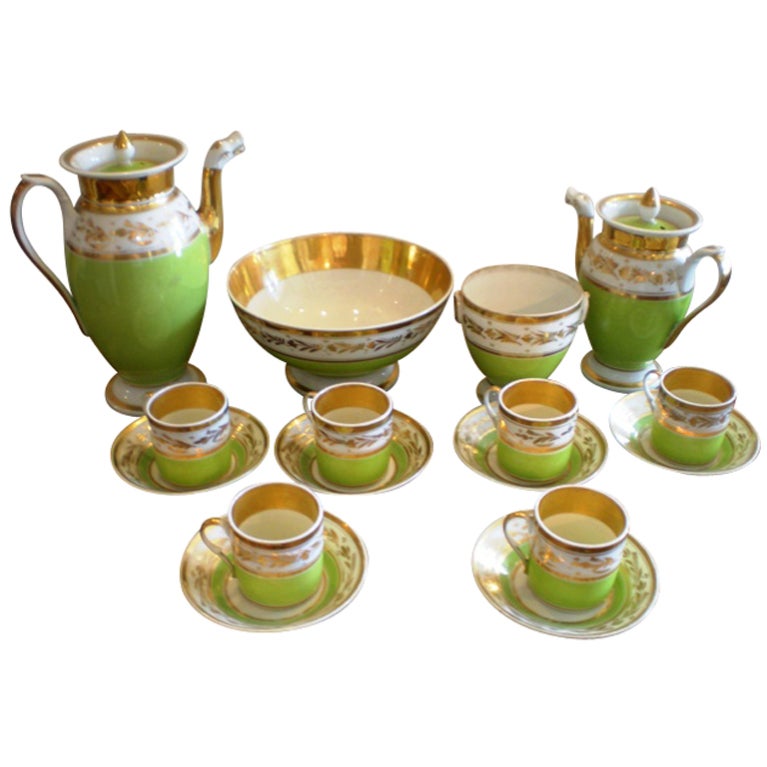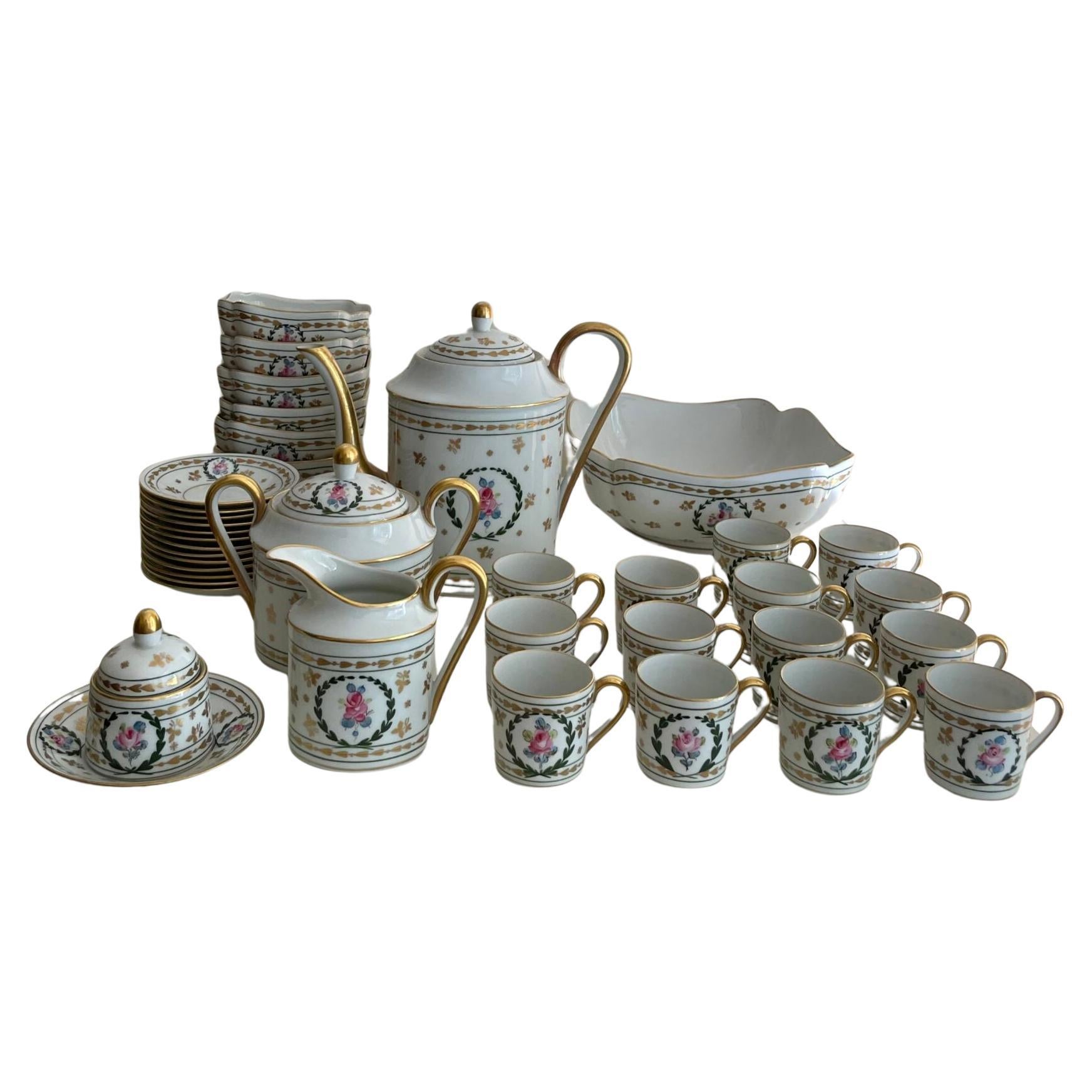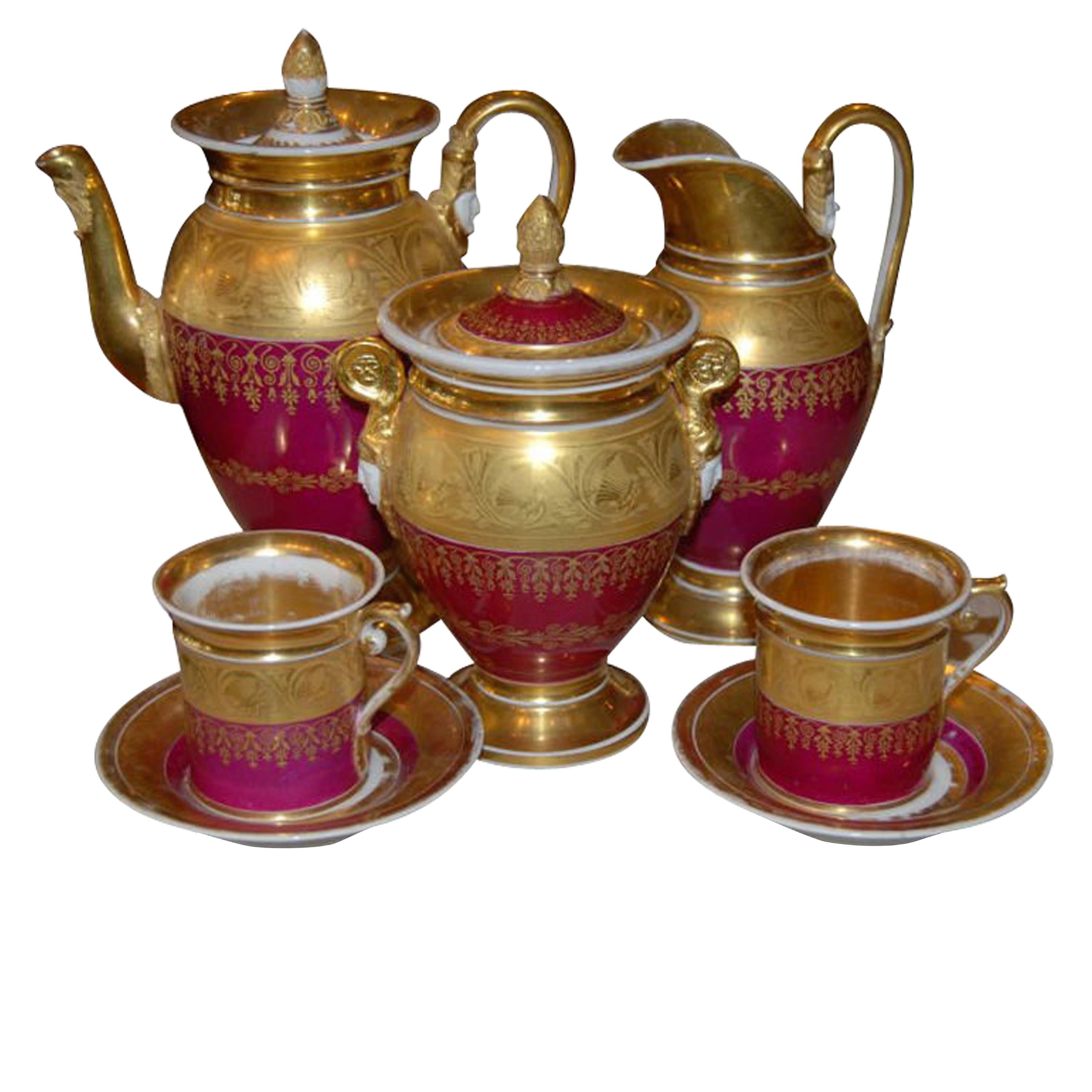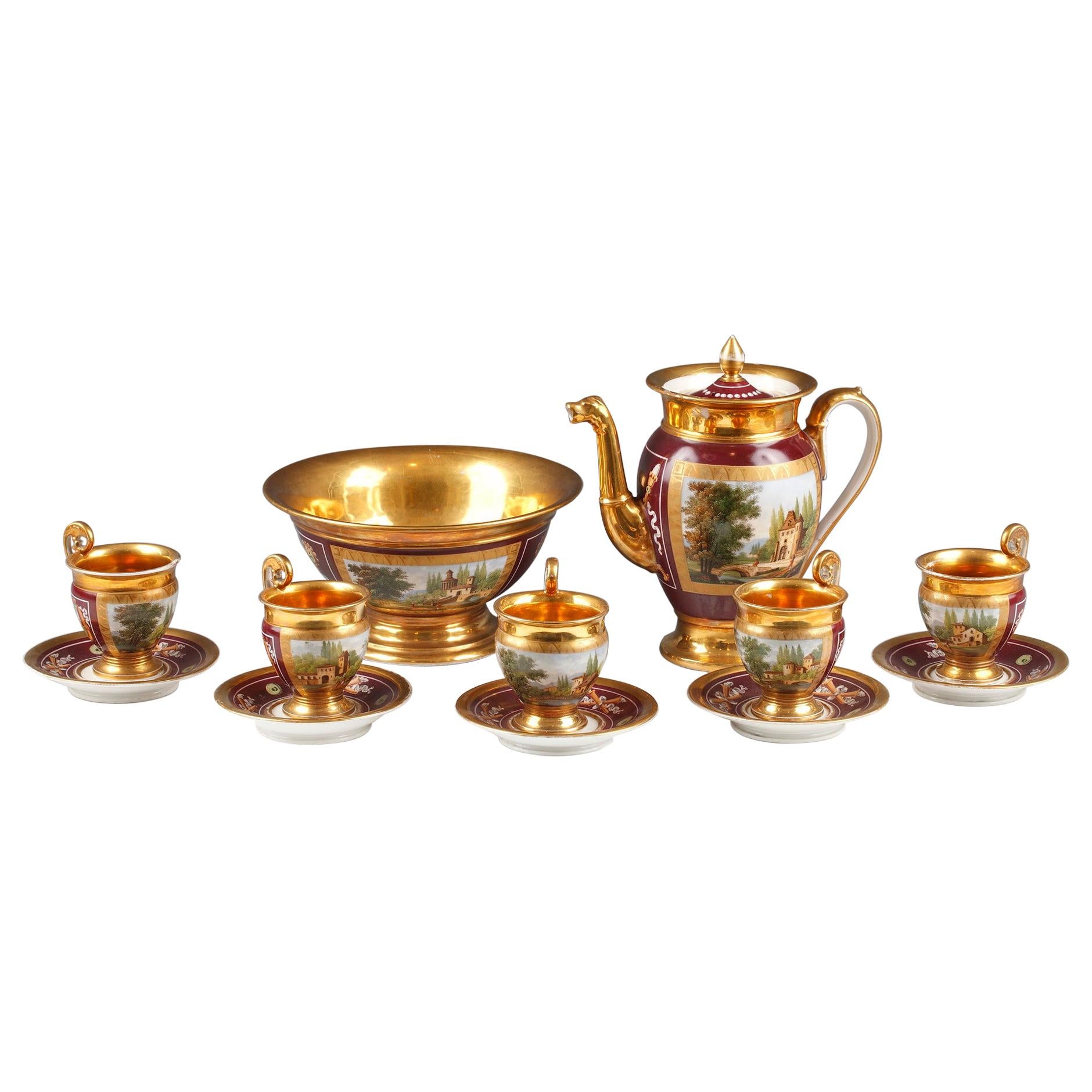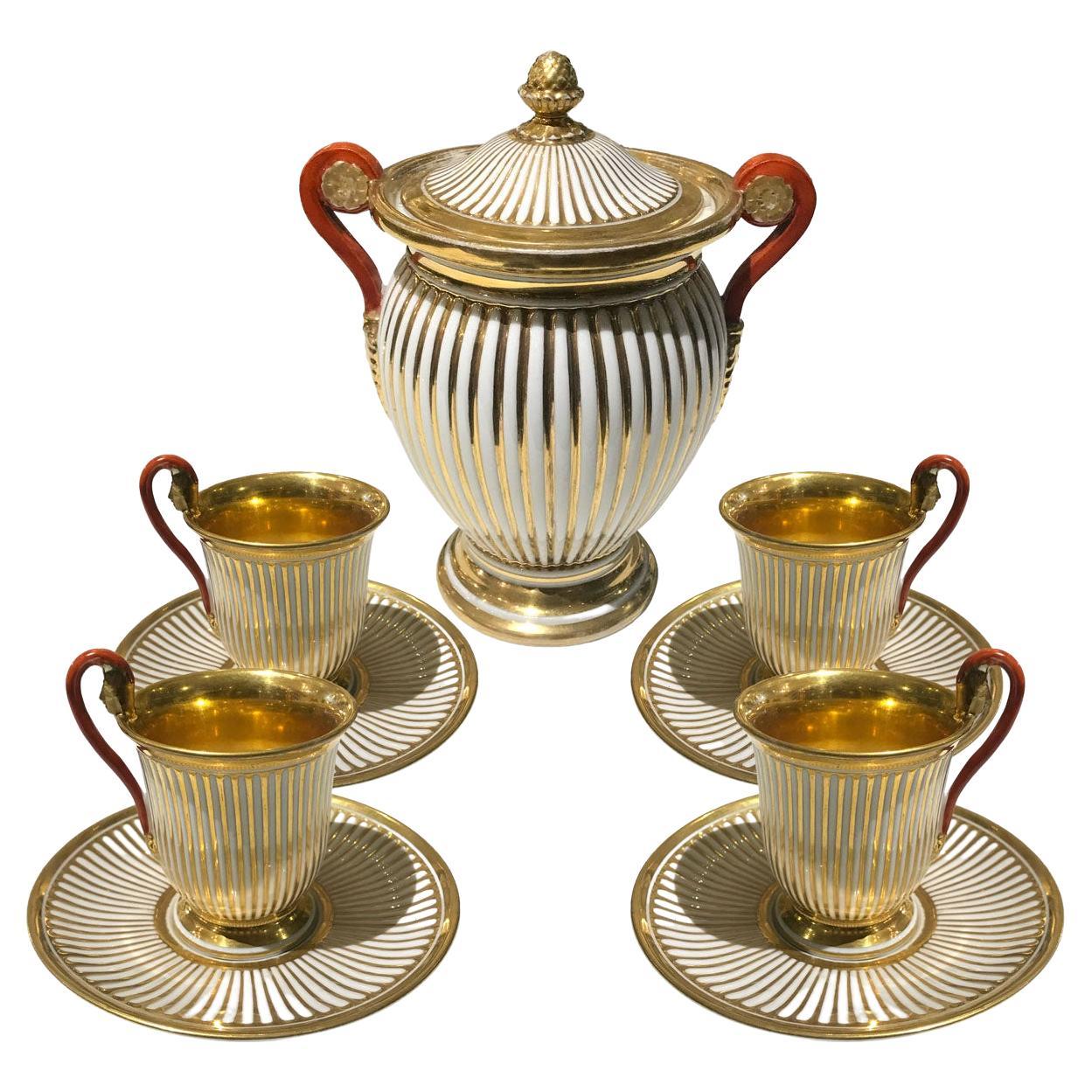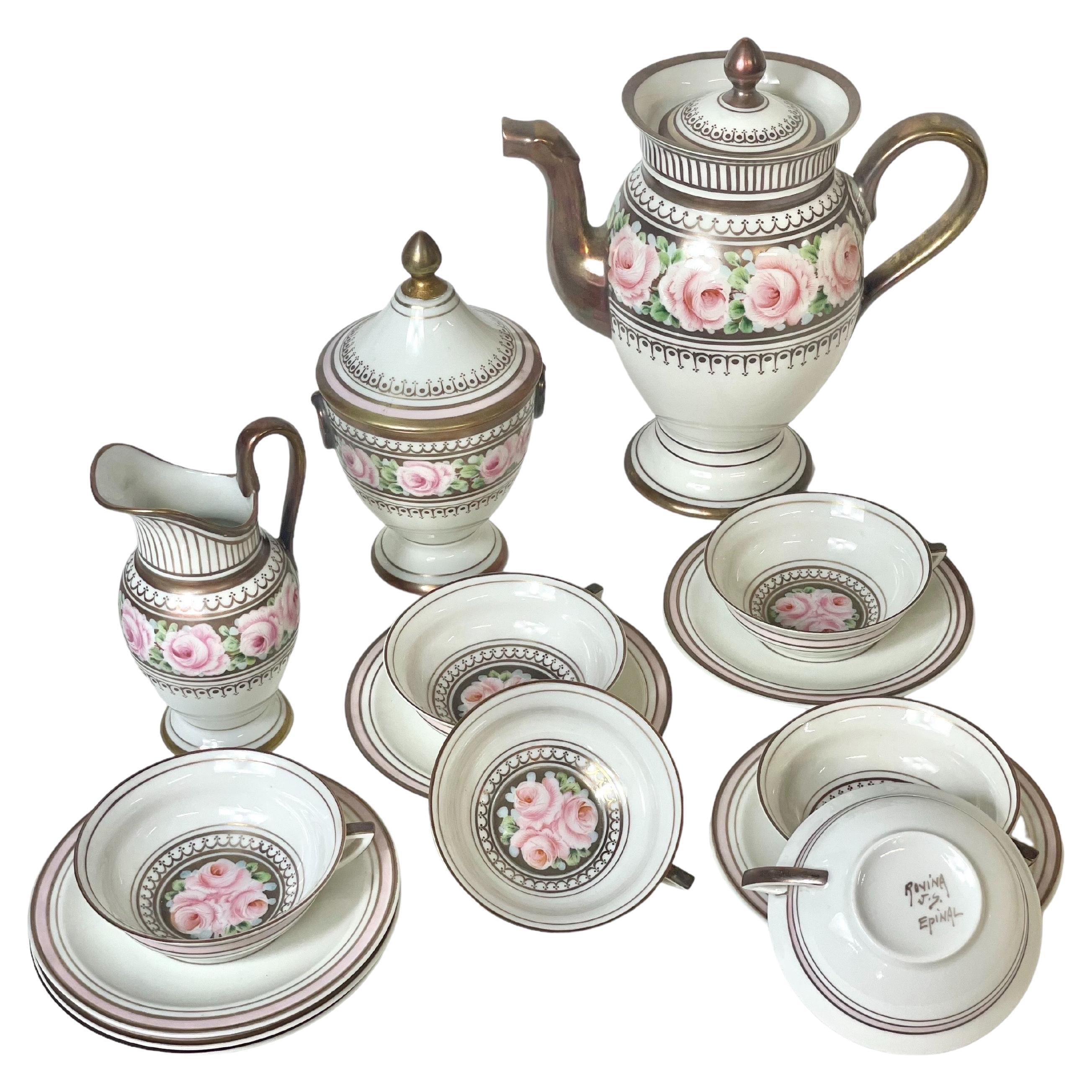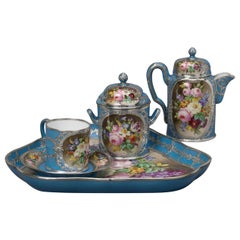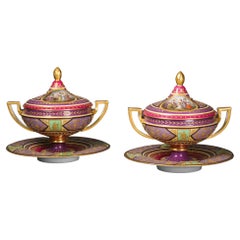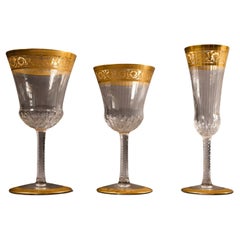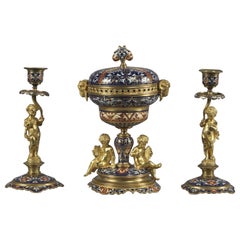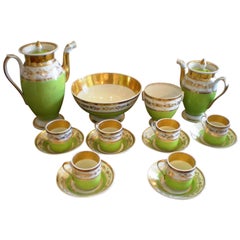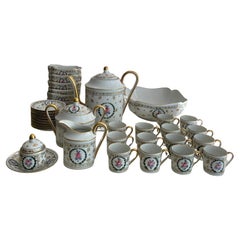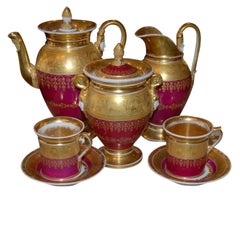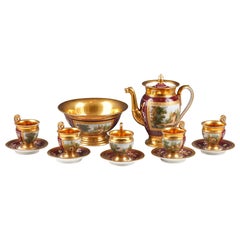Items Similar to A Fine Paris Porcelain Empire Coffee Service
Want more images or videos?
Request additional images or videos from the seller
1 of 5
A Fine Paris Porcelain Empire Coffee Service
$30,290.60
£22,000
€25,972.40
CA$41,662.96
A$46,341.16
CHF 24,310.50
MX$565,467.41
NOK 305,127.56
SEK 287,545.71
DKK 193,872.96
About the Item
A Fine Paris Porcelain Empire Gilt-Decorated and Floral Painted Coffee Service.
Comprising a coffee pot, hot-water pot, milk jug, sugar bowl and twelve cups and saucers. Each piece finely painted with a wide floral band within gold tooled borders on a burnished gilt decorated ground, the coffee and water pots with finely modelled dragon mask spouts.
In excellent original condition.
France, Circa 1830.
The importance of the Parisian porcelain industry stretches back to the time when under the reign of Louis XIV, all silverware in France was melted into coins, and as a result all dishes needed to be replaced by a different material. This brought about an immediate demand for porcelain from China (the sole supplier of porcelain since Vasco De Gama brought the first porcelain objects back to Europe during the 15th century). This was a very expensive commodity, and as such the need to create local porcelain was paramount, and once it was made possible a thriving local industry built up. The area around the rue de Paradis has been Paris's showcase of porcelain and crystal since the Restoration, when the Comte d'Artois, later to become Charles X, and his son, the Duc d'Angoulême and last Dauphin of France, were the first to set up porcelain workshops here, soon to be followed by others.
Amongst the famous artists who at some time worked in the Parisian porcelain industry was Pierre Auguste Renoir, who was apprenticed as a painter to a Paris porcelain-maker between 1854-1858.
- Dimensions:Height: 11.03 in (28 cm)
- Style:Empire (Of the Period)
- Materials and Techniques:
- Place of Origin:
- Period:
- Date of Manufacture:Circa 1830
- Condition:Wear consistent with age and use.
- Seller Location:Brighton, GB
- Reference Number:Seller: B542301stDibs: LU1028041301982
About the Seller
5.0
Recognized Seller
These prestigious sellers are industry leaders and represent the highest echelon for item quality and design.
Established in 1964
1stDibs seller since 2014
58 sales on 1stDibs
Typical response time: 6 hours
Associations
The British Antique Dealers' AssociationLAPADA - The Association of Arts & Antiques Dealers
- ShippingRetrieving quote...Shipping from: Brighton, United Kingdom
- Return Policy
Authenticity Guarantee
In the unlikely event there’s an issue with an item’s authenticity, contact us within 1 year for a full refund. DetailsMoney-Back Guarantee
If your item is not as described, is damaged in transit, or does not arrive, contact us within 7 days for a full refund. Details24-Hour Cancellation
You have a 24-hour grace period in which to reconsider your purchase, with no questions asked.Vetted Professional Sellers
Our world-class sellers must adhere to strict standards for service and quality, maintaining the integrity of our listings.Price-Match Guarantee
If you find that a seller listed the same item for a lower price elsewhere, we’ll match it.Trusted Global Delivery
Our best-in-class carrier network provides specialized shipping options worldwide, including custom delivery.More From This Seller
View AllSilver Mounted Sèvres-style Porcelain Cabaret Set, French, circa 1880
By Manufacture Nationale de Sèvres
Located in Brighton, West Sussex
A fine silver mounted Sèvres- style porcelain cabaret set.
The Sèvres Porcelain Manufactory was founded to the east of Paris in the disused Royal Château of Vincennes, late in 173...
Category
Antique Late 19th Century French Porcelain
Materials
Porcelain
Fine Pair of Vienna Style Porcelain Tureens and Cover
By Royal Vienna Porcelain
Located in Brighton, West Sussex
A fine pair of Vienna Style Porcelain tureens and covers.
Each cover with finely painted figural mythological scenes of Venus, Cupid and nymphs in the style of Angelica Kaufmann...
Category
Antique 19th Century Austrian Ceramics
Materials
Porcelain
A Forty-Three Piece Table Service by La Cristallerie de Saint Louis
Located in Brighton, West Sussex
A Rare Crystal and Gilt Forty-Three Piece Table Service by La Cristallerie de Saint Louis. This fine and luxurious service is in the famous ‘Thistle’ pattern developed by La Cristal...
Category
Early 20th Century French Glass
Materials
Crystal
Fine Gilt-Bronze and Champlevé Enamel Garniture Set, circa 1890
Located in Brighton, West Sussex
A fine gilt bronze and Champlevé Enamel Garniture Set comprising a pair of candelabra and a brûle-parfum and cover.
French, circa 1890.
The brûle -parfum or censor with a domed champlevé enamel lid above a gilt bronze pierced guilloche border with ram's head mounts supported by a baluster column flanked by seated putti finely cast with musical instruments on a circular base. The candelabra en suite having a pair of of putti figures supporting candlearms with circular champlevé enamel drip trays and sconces.
Champlevé enamelling, is similar to cloisonné in that the enamel is applied to discrete cells separated by metal. However, in champlevé, cells or troughs are cast into or cut away from the metal base, leaving a raised metal line between the cells which forms the outline of a design. The cells are then filled with molten or powdered glass and fired.
Height of central vase: 25 cm
Width of central vase: 15 cm...
Category
Antique Late 19th Century French Louis XVI Vases
Materials
Bronze, Enamel
Fine and Decorative Gilt-Bronze and Cut-Glass Decanter Set, circa 1890
Located in Brighton, West Sussex
A fine and decorative gilt-bronze and cut-glass decanter set.
French, circa 1890.
This fine and decorative decanter set has a gilt-bronze box with glass panels and an 'up and...
Category
Antique 19th Century French Louis XIV Crystal Serveware
Materials
Bronze
A George II Style Silver Plated Warwick Cruet
Located in Brighton, West Sussex
A Fine George II Style Silver Plated Warwick Cruet.
The cinquefoil tray having a tall central handle with a leaf and figurative grip above a frame with a rococo armorial cartouche. ...
Category
Antique 19th Century English George II Serving Pieces
Materials
Silver Plate
You May Also Like
Set of porcelain de Paris coffee & tea service
Located in Washington, DC
Set of porcelain de Paris coffee & tea service - eighteen (18) pieces. Made famous during the Napoleon Period 1795 - 1830
Coffee pot - W - 8"; H - 10"
Te...
Coffee pot - W - 8"; H - 10"
Te...
Category
Antique 19th Century French Tea Sets
Materials
Porcelain
$2,850 / set
Limoges coffee service
By Limoges
Located in MADRID, ES
Hand painted coffee set by Limonges. Composed of; 1 bowl, 7 small bowls, teapot, sugar bowl, milk jug and 14 cups with plates.
Category
Vintage 1930s French Tea Sets
Materials
Porcelain
$713 / set
Paris Porcelain Tea Set
Located in New Orleans, LA
Fabulous Porcelain Tea Set
Category
Antique 19th Century French Tea Sets
Materials
Porcelain
$6,500 / set
Paris Porcelain Restauration Style Tea Set, France, Circa 1880
Located in PARIS, FR
Charming Restauration style Paris porcelain tea set with red and gold Amati background, composed of a teapot, five cups with winding handle and their saucer, and a bowl. This set, li...
Category
Antique 1880s French Restauration Tea Sets
Materials
Gold
$2,855 Sale Price / set
50% Off
Empire style Coffee Set Porcelain Darte Frères
By Darte Frères
Located in Paris, FR
Very rare coffee set composed of 5 pièces : 4 cups with their saucer, and 1 sugar bowl. Whole set in porcelain with stripes patterns made of gold. Handles are painted in red, with an Egyptian-style gilt figure on it. Inner part half gilt.
Work from the early 19th century period, in the style of Empire or made during it.
Signed with red letters stamped "DARTE / FRERES / A PARIS" on the saucer.
Darte Frères was a Parisian porcelain...
Category
Antique Early 19th Century French Empire Porcelain
Materials
Porcelain
$4,698 / set
Vintage Porcelain Tea Service Set
Located in LA CIOTAT, FR
A stunning French Empire style coffee service, dating from around 1950, and comprising a coffee pot, six cups and saucers, a lidded sugar bowl and a cream jug. Crafted from white and...
Category
Mid-20th Century French Restauration Tea Sets
Materials
Porcelain
$1,200 / set
More Ways To Browse
Porcelain Dishes With Gold
Antique Coffee Service
Antique Water Pot
Antique Coffee Makers
Milk Glass Cups
Paramount Silver
Empire Cup
French Coffee Pots
Antique Glass Milk Jugs
Antique Porcelain Coffee Sets
Silver Water Pot
French Coffee Bowl
French Silver Coffee Pot
Antique Glass Coffee Maker
Chinese Sugar Bowl
Dragon Cup
China Silverware
Chinese Dragon Bowl
